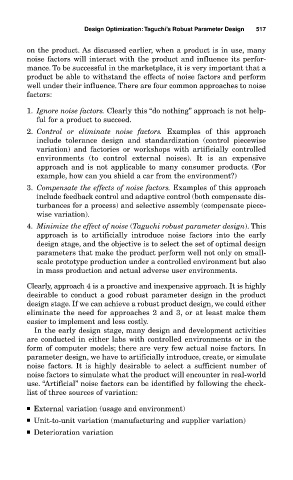Page 559 - Design for Six Sigma a Roadmap for Product Development
P. 559
Design Optimization:Taguchi’s Robust Parameter Design 517
on the product. As discussed earlier, when a product is in use, many
noise factors will interact with the product and influence its perfor-
mance. To be successful in the marketplace, it is very important that a
product be able to withstand the effects of noise factors and perform
well under their influence. There are four common approaches to noise
factors:
1. Ignore noise factors. Clearly this “do nothing” approach is not help-
ful for a product to succeed.
2. Control or eliminate noise factors. Examples of this approach
include tolerance design and standardization (control piecewise
variation) and factories or workshops with artificially controlled
environments (to control external noises). It is an expensive
approach and is not applicable to many consumer products. (For
example, how can you shield a car from the environment?)
3. Compensate the effects of noise factors. Examples of this approach
include feedback control and adaptive control (both compensate dis-
turbances for a process) and selective assembly (compensate piece-
wise variation).
4. Minimize the effect of noise (Taguchi robust parameter design). This
approach is to artificially introduce noise factors into the early
design stage, and the objective is to select the set of optimal design
parameters that make the product perform well not only on small-
scale prototype production under a controlled environment but also
in mass production and actual adverse user environments.
Clearly, approach 4 is a proactive and inexpensive approach. It is highly
desirable to conduct a good robust parameter design in the product
design stage. If we can achieve a robust product design, we could either
eliminate the need for approaches 2 and 3, or at least make them
easier to implement and less costly.
In the early design stage, many design and development activities
are conducted in either labs with controlled environments or in the
form of computer models; there are very few actual noise factors. In
parameter design, we have to artificially introduce, create, or simulate
noise factors. It is highly desirable to select a sufficient number of
noise factors to simulate what the product will encounter in real-world
use. “Artificial” noise factors can be identified by following the check-
list of three sources of variation:
■ External variation (usage and environment)
■ Unit-to-unit variation (manufacturing and supplier variation)
■ Deterioration variation

